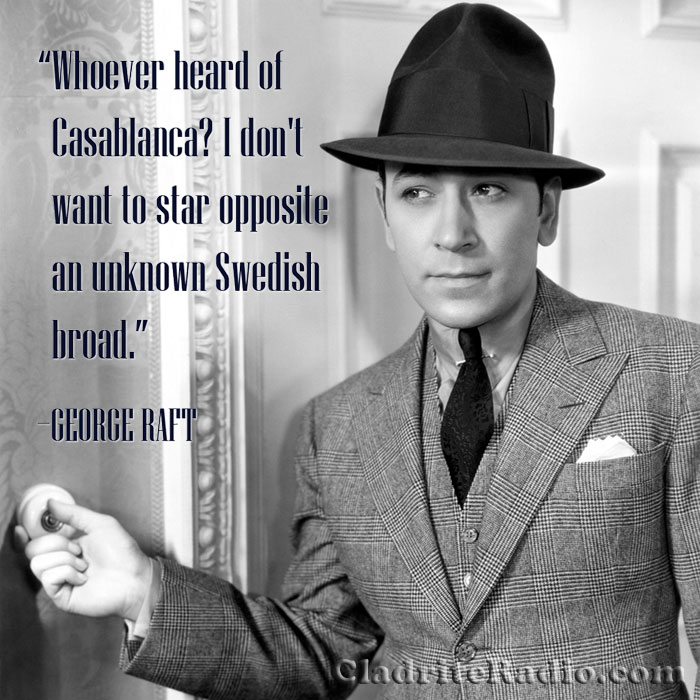Here are 10 things you should know about Helen Vinson, born 113 years ago today. Her Hollywood career was relatively brief—she appeared in just over three dozen movies—but memorable.
Tag: James Cagney
10 Things You Should Know About Joan Blondell
Here are 10 things you should know about Joan Blondell, born 114 years ago today. She’s a favorite here at Cladrite Radio; if her name is in the credits, we’re watching.
10 Things You Should Know About Rita Hayworth
Here are 10 things you should know about the beautiful and talented Rita Hayworth, born 101 years ago today. She enjoyed a charmed career but her life was, in many ways, difficult.
Precode Movies 101: TCM Offers a Primer for Beginners
We’ve acknowledged that the precode era is one of our favorite era in movie history. For those that might not know, precode movies are those made after the ascent of sound but before the Hayes code, which greatly restricted the plot, language, and attitudes that Hollywood pictures were allowed to portray, began to be strictly enforced by the Breen office in 1934.
That quaint, wholesome quality you may associate with old movies? The pictures of the 1930s and ’40s that might convince you, if you don’t already know better, that life was simple, pure and uncomplicated back in the good old days? Those came after the code kicked in. Precode movies are another thing altogether.
Some pictures that typify the precode era are playfully bawdy; others are downright gritty, sometimes even a bit shocking today (though rarely very graphic, by our standards). Tomorrow (Tuesday, July 31st), TCM is giving precode neophytes the chance to do some serious catching up, as they’ll be airing precode favorites all day long, from 6am till 8pm. If you’ve ever wondered what the fuss was all about, here’s your chance to educate yourself.
If it’s gritty you’re looking for, we’d recommend Safe in Hell (1931) and Three on a Match (1932); if you’re just looking for a little salty fun, give Jewel Robbery (1932) and Blonde Crazy (1931) a look. But honestly, we recommend loading up your DVR with every one of these entertaining pictures; they all have something to recommend them.
Here’s the line-up (all times Eastern):
6:00 am — Downstairs (1932)
7:30 am — Loose Ankles (1930)
8:45 am — She Had to Say Yes (1933)
10:00 am — Faithless (1932)
11:30 am — Hell’s Highway (1932)
12:45 pm — Safe in Hell (1931)
2:00 pm — Jewel Robbery (1932)
3:15 pm — Three on a Match (1932)
4:30 pm — Footlight Parade (1933)
6:30 pm — Blonde Crazy (1931)
Happy 115th Birthday, George Raft!
Actor George Raft was born George Ranft 115 years ago today in the Hell’s Kitchen section of New York City. Raft is perhaps as well known today for the movie roles he turned down as those he accepted. Here are 10 GR Did-You-Knows:
- His parents were of German descent.
- From his youth, Raft took a great interest in dancing, and his skills as a hoofer would serve him well as he found his way as a performer. In his salad days, he made money performing (and dancing with the lady patrons) at establishments such as Maxim’s, El Fey (with Texas Guinan) and various other night spots.
- He married Grace Mulrooney, who was several years his senior, when he was 22. They separated early on, but never divorced (perhaps because Raft’s family was Catholic), and he supported her until she died in 1970.
- Raft was known to run with a pretty rough crowd. He was childhood friends with gangsters Owney Madden and Bugsy Siegel; Siegel stayed at Raft’s home in Los Angeles when the gangster first moved there.
- Raft reportedly turned down the lead roles in High Sierra (1941), The Maltese Falcon (1941), Casablanca (1942) and Double Indemnity (1944). The first three of those roles proved to be great successes for Humphrey Bogart.
- Raft appeared in Mae West‘s first (Night after Night, 1932) and last (Sextette, 1978) pictures.
- In James Cagney‘s autobiography, the actor wrote that Raft prevented Cagney from being rubbed out by the mob. Cagney was president of the Screen Actors Guild at the time, and the story goes that he was adamant the Mafia wouldn’t become active in the union’s affairs, which was not a popular stance in certain circles.
- Raft was a lifelong baseball fan, attending the World Series for 25 years in a row in the 1930s, ’40s and ’50s.
- As a teen, Raft was a bat-boy for the New York Highlanders (later the Yankees).
- In the late 1950s, Raft worked as a celebrity greeter at the Hotel Capri, a Mafia-owned casino in Havana. He was there in 1959 when rebels stormed Havana to overthrow dictator Fulgencio Batista.
Happy birthday, George Raft, wherever you may be!

